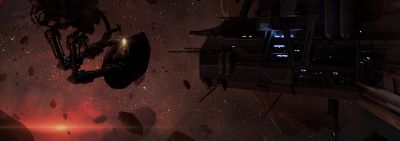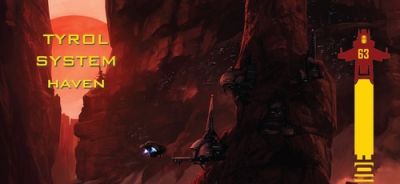
A system on the brink of death, the Tyrol system consists of seven planets orbiting a late-stage red giant. While such estimates are difficult to make at a scale much below geological time, scientists believe that the star could expand and go supernova at any time in the next several thousand years. With the risk factor being so hard to calculate, the 地球联合帝国, in hopes of keeping casualties to a minimum when the star does collapse, has designated Tyrol a scientific research zone. This means that no one can own property in the system and any orbital structures need government approval. A number of entities, ranging from non-profit educational institutions to high level weapons manufacturers, have invested in expeditions to Tyrol aimed at studying the star’s progress as well as other experiments that would be too hazardous to undertake in more populated systems.
There has however, emerged another reason to make the trek to Tyrol beyond scientific pursuits. Almost completely void of an 地球联合帝国督导局 presence and with 地球联合帝国海军 forces kept to a bare minimum, many come to the system to avoid the watchful eye of the law. Tyrol has emerged in the popular consciousness as being synonymous with wild, reckless abandon. The outlaws and miscreants who have chosen to populate the system’s two unofficial settlements are often looked upon as romantic figures, Humans who have made the ultimate decision not to fear death and to live free. The reality is that most inhabitants of Tyrol made the choice out of desperation or simply because they had nowhere else to go.
Inner Planets
The first planet in the Tyrol System is a charred husk slowly being sublimed by the red giant. A series of connected research stations was constructed on the planet’s largest surviving moon in 2930, as part of a research proposal to study a dying star up close. The consortium operating the base was able to do so for barely a decade; funding was cut in 2941 and the facility was quickly overtaken by a small smuggling community made up of squatters and malcontents. Known today as ‘Front Row,’ the moon’s population has an appropriately dark sense of humor about the fact that they will be the first to experience Tyrol’s supernova process.
Unlike Haven, another unlikely settlement on Tyrol V, the inhabitants of Front Row are rarely permanent. If you are looking for illegal goods and do not want any risk of police involvement, the dealers and fixers of Front Row are your best bet. It has become a place to meet with everyone from narcotics dealers to unscrupulous contract killers, with the providers of both passing through only so long as to hawk their wares. Just be mindful of the fact that you might find the entire system obliterated without notice should you schedule too long a layover!
The second and third planets in the system are less noteworthy. Scientists believe that Tyrol II was at one time a SuperEarth; today, it is an unrotating, flame-licked iron core. Tyrol III, although mineral-rich, is a similar graveyard. Discussion is ongoing as to whether it was a world destroyed by the star’s evolution or if it had never completely formed in the first place. With the exception of scientific expeditions studying the surface, there is no reason to attempt a landing on Tyrol III.
Mid-System
In distant ages, Tyrol boasted a healthy green band that included both the system’s asteroid field and the fourth planet. The asteroid field, a particularly dense one which likely would have become a planet given additional time, continues to furnish scores of valuable minerals sought after by miners that have the resources to bring their own equipment and aren’t afraid of operating in a lawless system. Tyrol IV, speculated to have been a gas giant that has had its atmosphere completely stripped away, was initially a source of gemstones once generated by the gaseous overpressure; today, its valuable resources are much harder to find.
Tyrol V (Haven)
A likely candidate for the most interesting world in the Tyrol System is the fifth planet. The home of Haven, Tyrol V is interesting for one simple reason — the fact that it has locals at all. Formerly an icy ball, Haven’s surface was melted away by the star’s evolution into a red giant. What remains is a desolate rock, snaked with surface chasms and massive underground caverns generated by millennia under ice.
It’s here, hidden beneath the surface’s now-oppressive heat, that a peculiar blend of homesteaders, outlaws and nihilists make their homes. In popular culture, Haven is considered the ‘last chance’ for the irredeemable: a home for those that can no longer make their way in the civilized universe and those that no longer wish to. The ever-present threat of supernova looms large over the planetary culture, but it is ultimately treated as a fact of life. No resources are spent on evacuation transports or early warning systems; if you have chosen to live among the renegades on Haven, you have likely made peace with a world capable of snuffing out your live in an unexpected instant.
Visitors are cautioned not to leave the shade of Haven without heavy thermal shielding. An unprotected individual can survive mere moments of exposure on the planet’s surface.
Outer Planets
The sixth planet in the Tyrol System is a typical Jovian-style gas giant. A churning mass of colored hydrogen and helium, Tyrol VI has thus far been minimally affected by the star’s decline. The planet is frequently used for refueling by those foolish enough to transit the system, although there are no proper refineries. Independent scientists have camouflaged a high-tech holography transmitting rig inside an asteroid at one of the planet’s Lagrange points, aiming to record what will likely be a very impressive light show should the supernova ultimately ignite the atmosphere (the astrophysics community is divided as to whether or not this will actually occur.) The hope is that the comm drone will be able to clear the jump point before the system burns.
The final planet in Tyrol is a small protoplanet whose formal status is hotly debated among those few who care. Whether “Seven” (as it is referred to in-system) is technically a planet or not, it is expected to be the only orbiting object not immediately impacted when the star goes nova. Several universities have discussed converting the planetoid into a permanent, manned deep-freeze base from which the process can be safely observed, although no one has locked down the requisite funding for such a venture.


